The iPhone 4 Redux: Analyzing Apple's iOS 4.0.1 Signal Fix & Antenna Issue
by Brian Klug & Anand Lal Shimpi on July 15, 2010 12:28 PM EST- Posted in
- Smartphones
- Apple
- iOS 4
- iPhone 4
- Mobile
Better at the Low End, Mixed Feelings Everywhere Else
Brian came up with the plan to enable the numerical signal strength visualization and executed on it very well in our original iPhone 4 review. Since then there’s been a disturbing amount of debate as to whether or not this actually amounts to a problem with the phone.
Part of the confusion stems from the fact that doing this sort of antenna testing in a real world scenario is time intensive. As Brian mentioned on the previous page, for today’s article both of us were driving around our respective cities, stopping at various locations, measuring signal strength and comparing it to bar mappings in order to produce the charts you saw on the other page.
There’s no denying that Apple has played a significant role in why there continues to be debate about the iPhone 4 antenna. By simply addressing the pre-4.0.1 bars not being a good representation of signal strength and ignoring the fact that the iPhone 4 does lose more signal strength than competing phones depending on how you hold it, Apple manages to convince its faithful that there’s nothing wrong while driving its critics to demand a recall.
My mother always taught me that honesty is the best policy and presumably I’m not the only one in the world who was privy to this information. Had Apple come clean with both of these facts (the bar mapping and the signal attenuation issue) early on we’d be in a far more clear cut world today.
We have consistently argued that the 4’s antenna is a design choice by Apple. As we’ve seen in our testing there are situations where the iPhone 4’s antenna makes things better (e.g. holding onto calls with very low signal strength) and other situations where the design makes them worse (e.g. holding it wrong in situations with low signal strength). I wanted to describe the inconsistency in greater detail so I went out with an iPhone 3GS and 4 and documented my experiences.
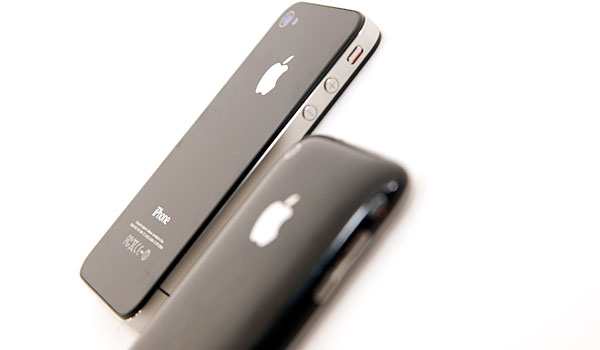
In practice I found three things that were true about the iPhone 4’s antenna behavior compared to the 3GS.
Reception in average conditions is sometimes significantly better on the iPhone 4 than on the 3GS. Take a look at the image capture below. In the same exact location we have better reception on the 4 than the 3GS. Granted this could be due to a number of variables outside of the phone’s antenna itself, but it happened enough times that it’s worth reporting. This is the positive to Apple’s external antenna design - you can and do get better reception. Unfortunately the tradeoff is the scenario I just described before this.
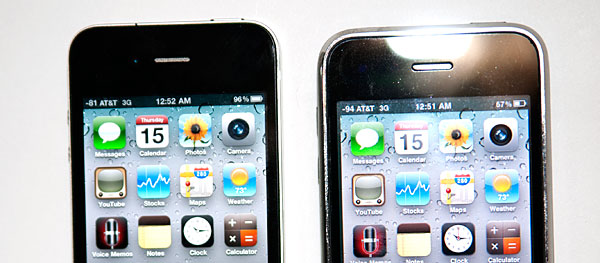
iPhone 4 (left) at -81 dBm vs. iPhone 3GS (right) at -94 dBm
Signal strength is sometimes the same as or worse than the iPhone 3GS. This is really where the problem comes into play. In the shot below I have the 4 and 3GS sitting next to one another and they are displaying roughly the same signal strength. We’ve already proven that holding the iPhone 4 attenuates its signal more than the 3GS, which results in the frustration we’ve seen expressed by many at this point. In situations where the 4 has the same signal as the 3GS, holding the phone is going to drop it to levels significantly worse than the 3GS. If you’re in an area with low signal strength to begin with, holding the phone is going to bring you down to dangerously low levels.
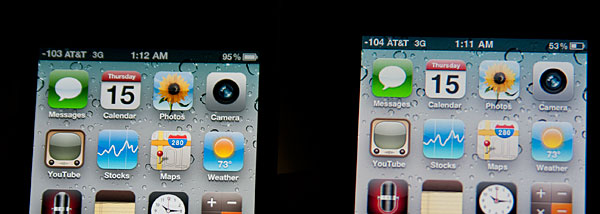
iPhone 4 (left) at -103 dBm vs. iPhone 3GS (right) at -104 dBm
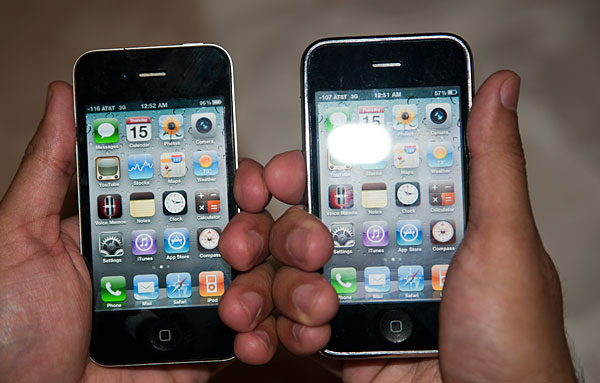
iPhone 4 being held tightly (left) at -115 dBm vs. iPhone 3GS being held tightly (right) at -107 dBm
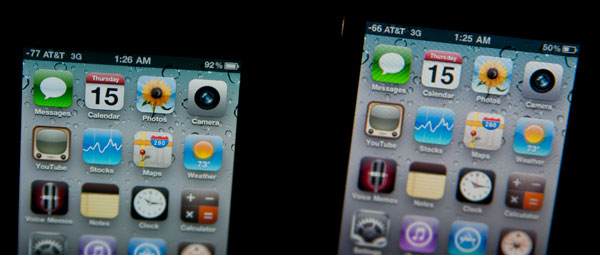
iPhone 4 (left) at -77 dBm vs. iPhone 3GS (right) at -66 dBm
The iPhone 4 is better at holding onto calls and data at very low signal levels. We’ve mentioned this one before but it’s worth reiterating. The new antenna does let me make calls and transmit data at very low signal strength. With the iOS 4.0.1 update I was able to make a call at -115dB on the 3GS, however the call did drop within a minute of starting it. By comparison I was able to have a much longer conversation without dropping the call at -120dB on the 4. By no means is this a scientific comparison, but anecdotally both Brian and I feel that the low signal strength performance of the iPhone 4 is better than the 3GS.

A call at -120 dBm on the iPhone 4
If you’re keeping tabs you’ll note that this is what is traditionally referred to as a trade off. Apple opted for good performance in low signal situations (and style of course) over maintaining consistently better or unchanged radio performance compared to the 3GS. I would personally consider this to be an unnecessarily risky design choice, particularly for a smartphone vendor. Note that it's nearly impossible to separate out the antenna from the rest of the iPhone 4 platform to determine exactly what is responsible for the phone's signal sensitivity in various situations. All we ultimately know is how physically interacting with the antenna impacts reported signal strength.
I can’t stress enough that this issue impacts all users. The variability is in how strong of a signal you have to begin with. That’s the absolute only reason there’s debate in these discussions from phone to phone. At my desk I don’t get great reception on AT&T. With the iPhone 4 I’m usually at -96dBm. If I keep a tight grip on the phone or if I’m holding it to send text messages I can sometimes lose all signal entirely. This is a combination of poor reception at my house and the fact that the 4 loses more of its signal than other phones when held certain ways.
Brian on the other hand has much better reception at his home. To him, the signal strength drops but it does not drop enough for this to be a problem. I consider myself to be on the border. If I’m mindful of how I’m holding the phone it’s not an issue, and even most of the time if I’m not paying attention to it it’s not an issue. However there are definitely times when it does become a problem. I wouldn’t consider it to be the majority of the time or even more than 10% of the time, but it happens enough for me to have to think about it. Ultimately this is why I consider Apple’s design here to be unnecessarily risky. Introducing a change with stylistic and technical benefits where the downside is limited but potentially very noticeable is just ballsy.
Luckily for Apple, there are things that can be done about it.










146 Comments
View All Comments
mfenn - Thursday, July 15, 2010 - link
Brian,Can you update the article with the exact part # or a link to that Kapton in the appropriate width?
Brian Klug - Thursday, July 15, 2010 - link
Hey mfenn,Updated the article with a link and specifics about the tape. I also discovered that what I thought was 5 mil thick tape is the 1 mil thick Kapton - still an amazing insulator though.
I didn't buy it online however, rather got it somewhere else locally. I don't know whether you can find that exact size online, but you can definitely cut it.
-Brian
Stokestack - Thursday, July 15, 2010 - link
And maybe elaborate on why you think the new system is more accurate, considering that (in a digital system) a large range of signal strength does give you "full service".Shouldn't a phone show full bars for the entire range of signal strength that gives you totally effective performance? At the weak end is where you see performance variation, so that's where the bars should vary as well.
What's the point of showing differing numbers of bars through a range that doesn't change the phone's performance?
lunarx3dfx - Thursday, July 15, 2010 - link
The difference, is that rf and digital are two totally different beasts. RF is like nothing you'll ever learn about. I have to deal with it a lot in the work that I do, and while a shift from -117 to -81 doesn't seem like that much, for every 3 dbm gain or loss, you are doubling or halving your signal strength (in wattage), but it still isn't that simple, for example a 10dbm signal will be expressed as 10 mW signal strength, a 20dbm signal will be 100 mW. You can't compare RF with anything else. It is it's own world.rushbc - Saturday, July 17, 2010 - link
i understand about the RF energy being different than anything, it really is its own world (i know, i work for AT&T).but i think stokestack has a good point. if -94 dBm gives you great service and good speed for voice/data, then the end user shouldn't care if the display shows one bar or ten bars--their phone is working, transferring data and voice with no issues. so a large dynamic range of signal strength that shows the end user 5 bars does make sense. five bars simply indicates that you have enough signal to do what you need to do, and your device has enough signal to do what it needs to do.
but since i do work for AT&T, and since i have talked to AT&T customers, i know that they DO care about the bars. i cannot tell you how many times people will tell me, "hey, i am only getting one bar on my cell phone at my office".
and i say, "well, can you make and receive calls?"
and they say, "Yes".
then i say, "well, can you connect to the internet on your phone without any problems?"
and they say, "Yes".
then i say, "well, what is the problem, then, sir?"
then they say, "but i am only getting one bar!" then i just smile to myself and try not to scream. it's almost like the famous old "who's on first" routine, but in real life.
so i predict many users will be confused by the "new" bars. and some will be angry. but Apple is doing the right thing by displaying the "more correct" signal bars. honesty really is the best policy.
Apple should really bite the bullet and completely ditch the whole bars thing.
it would be another way for Apple to show great leadership, bravery, and innovation. lets just get rid of the silly bars, totally. we need Apple to just go with strict numerical dBm readout. sure people will be confused. sure people will complain. sure there will be a learning curve. but it would be a quick adjustment. and within two years every smartphone in the world would be doing the same thing with numerical readouts in dBm, not bars.
it's called "standardization" (something completely lacking in signal strength indicators for wireless devices), and it would help the industry, and educate the consumers, and probably improve the wireless networks ability to respond to coverage needs and customer requests for network improvement. it would certainly help wireless consumers better understand how strong or weak their signal really is, and it could help people adjust their expectations accordingly.
"Death to the Bars!"
bring on the transparency of dBm numerical readouts on handset displays, i say.
Disclaimer: I am an AT&T customer and an iPhone owner. I am also an AT&T employee. I do NOT receive any form of compensation for my posts. My posts reflect my own personal opinions and do not necessarily represent AT&T’s positions, strategies or opinions. I also do not possess any "insider knowledge" of future products or future releases. And if I did, I certainly wouldn't tell you! :)
anandreader - Sunday, July 18, 2010 - link
"I just smile to myself and try not to scream..."
You're not listening to your customers. What they're telling you is that when the signal is weak, the voice quality is very poor. They may not be articulate enough to say that to you but that's the message that's being sent. You're just so fucking self-satisfied with your little syllogism that you're failing to hear the message. At&t's signal is crap in too many locations.
Your attitude clearly illustrates why people detest At&t.
thisma - Wednesday, July 21, 2010 - link
Anandreader, I suspect that rushbc's interpretation is accurate.Occasionally a user will have a real problem but describe it using some idea which is quite remote from the actual problem. I find, however, a good match in my comparison between rushbc's statements and how I expect users do express themselves.
My applicable knowledge, about how people communicate and what concerns users, has been developed during my several years of professionally teaching people how to use technology including, among other things, computers, phones, audio and video equipment, and all manner of peripherals.
oPad - Friday, July 23, 2010 - link
Wait a minute, it sounds like rushbc asked if there's anything wrong other than the bar strength display and they said "no",What's to articulate?
thisma - Wednesday, July 21, 2010 - link
Rushbc, I would love that! I fear however that the most prevalent perspective of users is that they don't care about precision of truth until they understand what that precision means. Even then a 5 bar display is so easy to interpret that a person doesn't even have to consciously check the indicator; if it's low you'll notice that out of the corner of your eye. My preference would be to have both the same way, perhaps, as you can optionally have the battery life indicator shown with the percentage of battery life next to it.bigboxes - Saturday, July 17, 2010 - link
Sound waves act very similar.